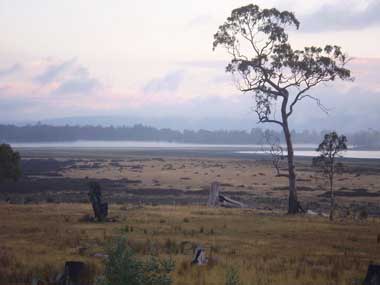The Interlaken Lakeside Reserve Ramsar site lies approximately 20 kilometres west of the township of Tunbridge, Tasmania at an altitude of about 800m above sea level. The site includes the north-western corner of Lake Crescent, the marshy areas at the lakes perimeter, as well as Lakeside Island and a large section of the dry land between Lake Crescent and Lake Sorell. The site excludes the private property block within it. Lake Crescent is a permanent freshwater water body. It is separated from Lake Sorell to its immediate north by a low strip of land, and the waters in each lake are connected by the Interlaken Canal and a drain through the marsh. Although the drain and canal control water flowing into Lake Crescent, and the outlet structure on Lake Crescent controls water exiting the lake, water levels are still influenced by rainfall and evaporation, which can result in large fluctuations in lake levels. In drought periods lake levels drop considerably. Freshwater aquatic vegetation communities are present on the site with the dominant plant species present being Fine Twigsedge and Greater Waterribbons. Running Marshflower, Floating Clubsedge, Amphibious Watermilfoil and Floating Pondweed are also common. Lake Crescent has a high abundance of phytoplankton. The site supports a large population of the nationally endangered fish, Golden Galaxias. When full, the lake provides important habitat, for feeding, resting and breeding, for the Black Swan and up to five species of ducks. Five migratory bird species listed under international agreements, the Great Egret, Cattle Egret, Latham’s Snipe, White-bellied Sea Eagle and the Caspian Tern, have used the Interlaken Lakeside Reserve for feeding and resting. The Interlaken Lakeside Reserve is a public reserve and it is used for fishing, recreational boating, and duck shooting. The site is also traditionally country of the Lairmairrener people, who used the resources of the lake for food, including eels and birdlife.
Interlaken Lakeside Reserve

Government evidence of impact of climate change:
-
Australian Government, Interlaken Lakeside Reserve Ramsar Site, Ecological Character Description
The results show that the level in the lakes is likely to be lower under future climate scenarios due to a decrease in inflows and an increase in evaporation from the lakes.
The major threats to the ILR Ramsar site are presented in the following table. xii Potential impact Likelihood Timing Actual or likely threats or threatening activity Prolonged high or low lake levels (including impacts of climate change) Almost certain Immediate Possible Immediate Forestry activities adjacent to wetland such as clearing of native vegetation; partial harvesting or plantation establishment Inability of intermittent marshes to reproduce Decline in condition of vegetation Loss of soil seed bank Loss of spawning habitat and triggers for golden galaxias Sediment deposition and increased turbidity Nutrient enrichment Changes to hydrology Establishment of weeds Reduced habitat quality Low lake levels and associated impacts Inability of intermittent marshes to reproduce Decline in condition of vegetation Loss of soil seed bank Loss of spawning habitat and triggers for golden galaxias Water extraction for human and agricultural use Possible; subject Immediate to to legislation long term (subject to legislation) Almost certain Immediate Exotic plants and animals Increase in terrestrial or exotic flora Displacement of native wetland species Possible Exotic plants and animals Increase in trout numbers Increased predation of galaxias population Immediate to long term Possible Exotic plants and animals Introduction of increase in European carp Reduced water quality and increased turbidity Impact on native plants Immediate to long term Impact on native fish Possible Medium to long term Impact on frog population Almost certain Immediate Exotic plants and animals Introduction of other exotic fish species Exotic plants and animals Presence of chytrid fungus Exotic plants and animals Introduction of didymo (Didymosphenia geminata) Possible Adversely affect water quality; aquatic invertebrates and fish stocks Medium to long term xiii Limits of acceptable change 1.
Such a trend could be possible under conditions of climate change.
Sudden large changes in water levels inconsistent with climatic changes should be avoided particularly within the inundation zone of the intermittent marshes (803.0 803.3 metres AHD).
Almost certain threat is expected to occur in the short term (one to two years) Possible threat may occur in the short term (one to two years) Unlikely threat not expected in the short term but may occur in medium (three to five years) or long term (greater than five years) Rare Threat may only occur in extreme and or exceptional circumstances Table 5 Major threatening activities to the ILR Potential impact Likelihood Timing Actual or likely threats or threatening activity Prolonged high or low lake levels (including impacts of climate change) Almost certain Immediate Inability of intermittent marshes to reproduce Decline in condition of vegetation Loss of soil seed bank Loss of spawning habitat and triggers for golden galaxias Sediment deposition and increased turbidity Nutrient enrichment Changes to hydrology Establishment of weeds Reduced habitat quality Possible Immediate Forestry activities adjacent to wetland such as clearing of native vegetation; partial harvesting or plantation establishment Potential impact Likelihood Timing Actual or likely threats or threatening activity Water extraction for human and agricultural use Possible; subject to legislation Immediate to long term (subject to legislation) Low lake levels and associated impacts Inability of intermittent marshes to reproduce Decline in condition of vegetation Loss of soil seed bank Loss of spawning habitat and triggers for golden galaxias Displacement of native wetland species.
In the Sustainable Yields project; fifteen global climate models with three estimates of temperature changes due to global warming were used to provide a spectrum of possible climates.
Climate change predictions suggest that the long term prognosis for the Lakes Sorell and Crescent system is marginal in sustaining the supply and quality of water in the lakes.


